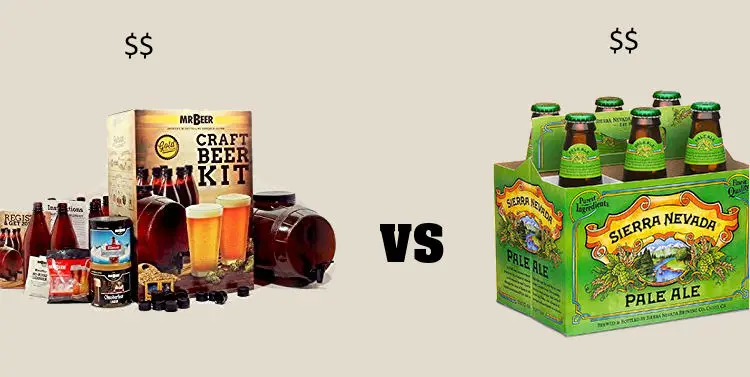Many people that start homebrewing consider it as a cost-effective idea. They are tired of going to the store regularly to pick up beer and paying a premium for fresh craft beer when they can easily produce it in their own home.
If you are getting into homebrewing is a cost-effective strategy, it’s important to remember upfront that you will be operating with a bit of extra expense. The basic items that you will need to get started with home brewing will get a bit expensive to start especially if you plan on investing in a glass carboy or a set of brand-new bottles with labels.
Brewing beer on the cheap with the help of a brew bucket, a simple air lock and a beer kit however can be extremely cost-effective for some of your first beer. The best part is that once you purchase these items, you can easily clean and sanitize them to make another batch of beer with another set of ingredients. The first batch of beer that you produce will often be far more expensive than what you would purchase it for at the store, it’s all of the other rounds of home brew that you make that can actually save you money over time.
Comparing the cost of homebrewing:
When we consider the cost of a pot, the beer kit, a new airlock, sanitizer and a beer kit it’s fairly likely that you could be spending around $100 or more to get started with your first batch of beer. A basic homebrewing kit (Tubing, airlock brew bucket, sanitizer, bottles) can be delivered for just over $110 with an ingredients kit coming in at around $25 for five gallons of beer, yeast is generally around $5.75 to pick up. This could put the cost of your first batch of beer at around $140.75.
Keep in mind that this would be the price for around 8.3 sixpacks of beer. Investing in all of these materials will also give you the option to reuse them with sanitizer and a new brew kit for your next batch of beer.
The first batch of beer might cost you as much as $16.95 for your 6 pack plus your time but on the second round of brewing you can really start to see cost savings. All you’ll need to replace for your second round of brewing is some sanitizer and a new brew kit. This can mean buying $5.75 worth of new yeast, a $25 ingredient kit, $5 on new sanitizer and then dividing your costs again over the same amount of beer. For the second round of homebrewing the costs of brewing five full gallons of beer would be around $35.75 or around $4.30 for a sixpack of beer.
1st batch : $16.95 for the equivalent of a 6 pack
2nd batch and followings : $4.30 for the equivalent of a 6 pack
Keep in mind that the quality of the beer that you can produce at home is typically far fresher than anything that you would get from a mass-produced brewery. Although it may not have the same consistent flavoring, you can get beer that’s comparable to what you would find at a local craft brewery for this price. With many craft breweries charging $15 or more for a 6 pack, the idea of getting a fresh batch of beer for $4.30 offers a considerable savings!
Are there varieties of beer that are more expensive to produce?
There are some varieties of homebrew that can be traditionally more expensive to produce. Usually this comes down to the variety of hops and ingredients that go into the beer. Any type of double IPA for example generally involves a more expensive hop bill and often requires a far longer brewing process.

Using kits can often be more costly when you are using a larger kettle. Having to buy several different kits to produce a larger batch of beer can add to the costs of brewing substantially. Changing over to all grain or even partial mash can start to save you money especially when you are brewing in large volume.
Some of the cheapest varieties of beer are often produced using corn sugar and other inexpensive ingredients. Some of the common beer styles that you can save money with include righties like English Brown ale, blonde/cream ale, Berliner Weiss, American loggers, Mile ales, and bitters.
Wit bier, Belgian Tripel, Eisbock and dry stouts often require extra care and attention as well as high-quality ingredients in order to brew. As these types of beers are generally only brewed in a few areas of the world, it can often be difficult to find quality recipes for homebrewing as well.
As you can see, homebrewing can help to save you money over time especially when you experiment with ingredients and start to find bulk grain ingredients that you can use to brew your own beer. Once you have the initial kit for home brewing and the expertise to go without using brewing kits, you can really cut your costs down and produce fresh beer for a fraction of what you might spend at a local brewing company.

